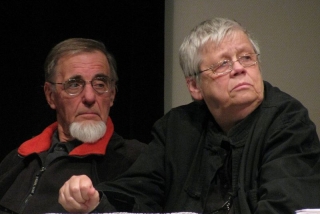Date: 5 March 2004 | Season: Vasulka Video
VASULKA VIDEO: PIONEERS OF ELECTRONIC ART
5—7 March 2004
London Candid Arts Trust & University of Westminster
Steina and Woody Vasulka began to use the medium of video as early as 1969, first documenting jazz performances, rock concerts and the underground activities of ‘illegitimate culture’. Exploiting the relationship between the electronic signals for both sound and image, they started a didactic exploration of the limitless possibilities of video processing using a range of newly crafted technological tools. Each tape produced was a by-product of the dialogue between the Vasulkas and their machines, as they systematically analysed and deconstructed the fundamental materiality of video through spatial, temporal and sound/image manipulation. The Vasulkas are the creative pathfinders of the electro-magnetic spectrum, whose works – infused with the fizz and crunch of the analogue age – are as mesmerising and astounding today as in their original moment of discovery.
Steina and Woody Vasulka will present three unique events during the weekend, which includes a continuous one-day gallery projection of key works.
STEINA & WOODY VASULKA: PIONEERS OF ELECTRONIC ART
VASULKA VIDEO: PIONEERS OF ELECTRONIC ART
5—7 March 2004
London Candid Arts Trust & University of Westminster
Since 1969, when they had their first access to primitive video equipment, the Vasulkas have conducted a dynamic exploration of the electro-magnetic image. Woody was born in Czechoslovakia in 1937 and trained as an engineer and filmmaker, Steina was born in Iceland in 1940 and became a professional musician. They married in 1964 and immigrated to America the following year. After seeing the ground-breaking TV as a Creative Medium exhibition at the Howard Wise Gallery in 1969, they devoted their activity to video, first documenting New York cultural events including jazz and rock concerts and underground performances using a Sony Portapak camera. Soon after, they began to experiment with using VCS3 and Buchla audio synthesisers to alter the electronic video signal, making their first image-processed tapes.
In 1971, together with Andy Mannick, the Vasulkas co-founded The Electronic Kitchen, an electronic laboratory for experimentation with sounds and images. The Kitchen soon became one of the artistic centres of New York, presenting screenings, performances and concerts ranging from the new music of La Monte Young to the new wave of Talking Heads, and it continues today as one of the city’s most prestigious multi-media art spaces.
Throughout the 1970s, the Vasulkas continued their tireless investigations into the phenomenology of video, with each tape produced being effectively a by-product of the dialogue between them and their machines. Steina and Woody did not create their images from video synthesisers; their unique approach involved the processing of previously recorded material through a series of modular units, frequently using the input of a separate electronic signal to control the effects.
Working in collaboration with creative engineers including George Brown, Bill Etra and Eric Siegel, they developed a new range of tools and devices with which they can further investigate the image. Their arsenal of analogue equipment contains the Rutt/Etra Scan Processor, Dual Colorizer, Multikeyer, Programmer, Horizontal Drift Variable Clock and the Field Flip/Flop Switcher. Much of their work explores and exploits the similarity of the sound and image signals, producing a mesmerising range of synaesthetic video before the onset of the digital age.
In 1973, the Vasulkas moved to Buffalo to teach at the Media/Study Center, where they become part of a faculty including filmmakers and theorists Tony Conrad, Hollis Frampton and Paul Sharits. The pair also began to work individually during this time. Steina embarked on the Machine Vision series, developing mechanical systems to control the camera, distancing it from the human viewpoint. Woody began to explore the digital realm, custom-designing the Digital Image Articulator. Both subsequently worked on interactive projects and large-scale installations, adding a sculptural or monumental element to their practice.
As pioneers of video art, Steina and Woody Vasulka stand alongside Nam June Paik, Peter Campus and Joan Jonas, with the Kitchen and their own studio as much a point of focus as the early activist groups Video Free America, Raindance and Guerilla Television and the innovative American television laboratories of NCET, WNET and WGBH. This weekend of events is the first opportunity in decades to see a substantial collection of the Vasulka’s early works in the UK, and a rare chance to hear the exuberant and vivacious duo discuss their work from a practical, rather than theoretical, point of view.
Back to top
